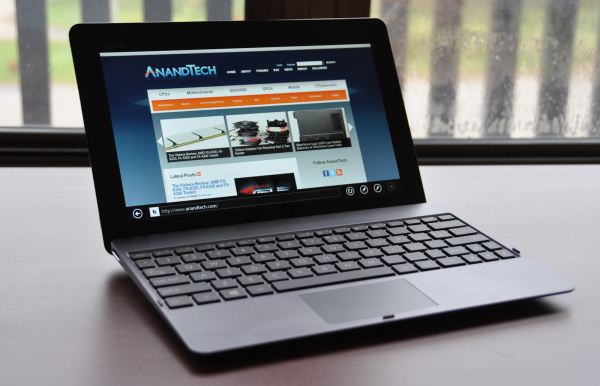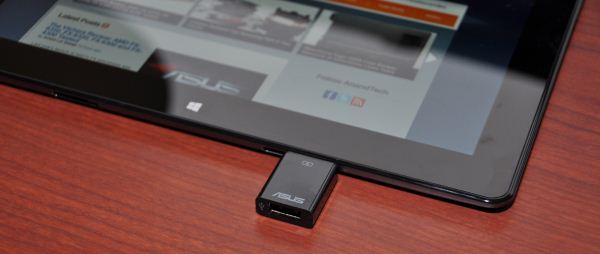ASUS VivoTab RT Review
by Vivek Gowri on October 23, 2012 3:01 PM EST- Posted in
- Asus
- Mobile
- Tablets
- Windows RT
- Vivo Tab
The ASUS Transformer line of tablets have consistently been among the strongest contenders in the Android tablet world, so when it was announced that they would be one of the launch partners for Microsoft’s Windows-on-ARM push, big things were expected. And so we have the ASUS VivoTab RT. The VivoTab name comes from the Latin verb “to live”, while the RT part is of course an indication of Windows RT, the official name for the ARM version of Windows. Windows RT-based tablets are Microsoft’s first real competitors built for the modern tablet market, so this is a hugely important launch for Microsoft as well as its hardware partners. Obviously the elephant in the room here is Surface and how Microsoft entering the hardware market changes the Windows 8/RT launch, but we’ll get to that part in time.
The division of Windows 8 (x86) and Windows RT (ARM) has resulted in a whole host of tablets with names ending in RT, and very similarly named examples running the x86-based Windows 8, so it’s worth keeping track of. For example, the VivoTab is x86-based, with Windows 8, Clover Trail, and an 11.6” display, a completely different product than the VivoTab RT that we have in front of us today. The RT is very important in making the distinction between ARM and x86 hardware platforms.
At first glance, the VivoTab RT looks pretty similar to what we’re used to seeing from the Transformer line, with a 10.1” IPS 768p display housed in a slim aluminum chassis and Nvidia’s Tegra 3 silicon underhood. The specsheet is actually pretty similar to the original Transformer Prime from last December, sharing identical width and thickness dimensions in addition to the obvious hardware-level similarities. The Transformer tablets have all been either 1280x800 or 1920x1200, so the switch to a 16:9 screen has allowed ASUS to make the VivoTab RT a bit shorter, as well as 60g lighter, than the Transformer Prime. At 1.15lbs, the VivoTab RT is quite the featherweight, helped along in this by the nano molding technology that injects liquid plastic to fuse the aluminum frame with the plastic components.
| Tablet Specification Comparison | ||||||
| ASUS VivoTab RT | Microsoft Surface for Windows RT | ASUS Eee Pad Transformer Prime | ASUS Transformer Pad Infinity | |||
| Dimensions | 263mm x 171mm x 8.3mm | 275 x 172 x 9.4mm | 263 x 180.8 x 8.3mm | 263 x 180.6 x 8.4mm | ||
| Chassis | Aluminum + Plastic | Magnesium | Aluminum | Aluminum + Plastic | ||
| Display | 10.1-inch 1366 x 768 Super IPS+ | 10.6-inch 1366 x 768 | 10.1-inch 1280 x 800 Super IPS+ | 10.1-inch 1920 x 1200 Super IPS+ | ||
| Weight | 525g | 680g | 586g | 594g | ||
| Processor | 1.3GHz NVIDIA Tegra 3 (T30 - 4 x Cortex A9 |
1.3GHz NVIDIA Tegra 3 (T30 - 4 x Cortex A9 |
1.3GHz NVIDIA Tegra 3 (T30 - 4 x Cortex A9) |
1.6GHz NVIDIA Tegra 3 (T33 - 4 x Cortex A9) |
||
| Memory | 2GB | 2GB | 1GB | 1GB DDR3-1600 | ||
| Storage | 32/64GB + microSD slot | 32/64GB + microSD slot | 32GB/64GB + microSD slot | 32/64GB + microSD slot | ||
| Battery | 24.4Whr | 31.5Whr | 25Whr | 25Whr | ||
| Pricing | $599/699 (includes dock) | $499/599 | $499/$599 | $499/$599 | ||
The heart of the VivoTab RT is a 1.3GHz T30, the same chip as the Transformer Prime and international HTC One X, amongst other devices. It’s paired with 2GB of DDR3L memory, 32GB of NAND storage, 2.4GHz 802.11n, Bluetooth 4.0, cameras front (2MP) and back (8MP with an LED flash and 1080p video), a 10.1” 1366x768 Super IPS+ panel, and a 25Wh battery. In addition, it has a microSD card slot, a micro-HDMI port, and the proprietary charging/dock connector. The port itself is different from the ones on the Transformers, the VivoTab RT uses a smaller and lower-profile connector. Included in the box is a USB 2.0 dongle that connects up to the dock connector. It’s a bit unwieldy, but it’s better than not having any options for USB support.
When the VivoTab RT went up for preorder, it was priced at $599/699 for the 32GB and 64GB versions, respectively, with various online retailers offering a pre-order bundle with the 32GB VivoTab RT and the laptop dock together for $749. Shortly before this review went live, however, I received an email from ASUS saying that final pricing would be $599 for the 32GB model including the docking station, with most of the focus being on selling the bundle rather than the individual pieces. This was likely a response to the more aggressive pricing of the Surface RT, which offers similar hardware for $499 (32GB), or $599 when bundled with the Touch Cover keyboard case. It’s good to see ASUS adjust to Microsoft’s pricing this quickly, but I’m not sure there was much of a choice there if they wanted to be competitive. The laptop dock is more functional than Microsoft’s keyboard covers and throws in a near-doubling of battery capacity for good measure, so the new pricing quickly turns the VivoTab RT into a good value.












68 Comments
View All Comments
lmcd - Tuesday, October 23, 2012 - link
Naw, Windows 8 still isn't interesting to me. Even oddball projects like Plasma Active are more interesting.augiem - Tuesday, October 23, 2012 - link
Except I HAVE actually used Windows 8, I do not agree, and its still inappropriate.rahvin - Tuesday, October 23, 2012 - link
I agree it's inappropriate. Calling your readers ignorant is not a way to build trust and I have to say honestly that comment damaged Anandtech's reputation.I'm using Win8 on my home rig and there are things I like about it (some nice performance enhancements) but metro is NOT one of them. Combining touch interface into the desktop was a natural evolution, but what MS did by trying to make one interface work for phones and desktops is going to be a big mistake IMO. Windows 8 is going to be much more hated than the Office Ribbon ever was. The hot corners, full windows start panel and re-emergence of the active desktop it provides are all going to be disastrous IMO.
Regardless of how you feel about Windows8 calling people Ignorant for disliking the UI isn't professional and I normally come to this site for professional well thought out reviews EVEN if I don't agree with the conclusions.
Alexvrb - Tuesday, October 23, 2012 - link
If you treat Modern UI like a fancy start menu, everything is fine. If you obsess about Modern UI and spend long hours glaring at it and muttering curses, then I can see where you might have a problem.Anyway if you're really hardcore into murdering the new start menu, there are options for that too. But you were obviously ignorant of this. Ooops! Was that inappropriate? Want some Pamprin? Ah damn there I go again being inappropriate. Probably not politically correct either.
VivekGowri - Tuesday, October 23, 2012 - link
It's the Metro/Modern user interface, being discussed in the context of using it with a mouse. I don't understand how it doesn't apply, considering this particular tablet is shipped with a keyboard/touchpad attachment.shomizu9 - Tuesday, October 23, 2012 - link
I happen to agree with your opinion in this article Vivek, but augiem has a point - using the "ignorant" comment in your article is pretty unprofessional (i.e. harsh) for someone writing an article/review :-( What about addressing it in a different, less harsh way?VivekGowri - Tuesday, October 23, 2012 - link
Yeah, I agree that it sounded a bit harsh in my head too but I was more focused on getting the article out in time rather than worry about that one word. Does "uninformed" sound better?EnzoFX - Tuesday, October 23, 2012 - link
What about the fact that it fills the screen? What if you don't want to lose visibility of windows you have open? That's gotta count for something, no?I myself use other launchers, so I shouldn't be affected =P.
MadMan007 - Tuesday, October 23, 2012 - link
Ignorant *does* mean uninformed, the word 'ignorant' has just gotten twisted by popular culture to be equivalent to 'stupid', which it is not.augiem - Tuesday, October 23, 2012 - link
How about, has a different opinion from. Honestly, the level of superiority on these tech boards is unbelievable.